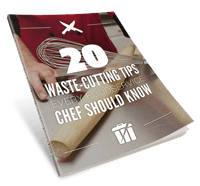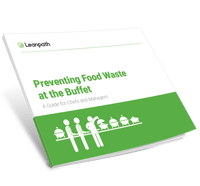Reducing food waste during the holiday season

The holidays can be tough on the planet. Road trips and flights to visit family. Christmas gifts shrouded in plastic. A lot of consumption and waste. As culinary professionals our focus this time of year is on guests and food. We are in the unique position on the front line to make the changes to combat the global food waste problem and be part of the solution. A lot of food gets wasted this time of year, so what can you do about it?
Chefs and cooks spend an enormous amount of time prepping, cooking, and displaying food in elaborate and plentiful buffets. But what happens when the party's over? What happens to all the leftover food that goes uneaten? Everyone loves the day-after meals at home, but what can you do in the restaurant to repurpose those food items that would be wasted?
Let’s look at a traditional holiday meal and look at ways to prevent, reduce, reuse, reinvent, and repurpose much of the food that in the past would have been wasted.
Before the event:
- Re-check the head counts for all the parties prior to ordering product. They might have changed and they might change again right before the event.
- Make sure you have clear portion sizes in mind and communicated to the staff prior to the event.
- Production sheets are the key. Keep all information updated on the sheets as final numbers roll in. Adjust any pull, prep, and production numbers as new information becomes available.
- Order only what you need for the event; break the habit of padding the food order “just in case.” Stick to your numbers.
Prepping the event:
- The production sheets have been written and adjusted for change in headcount: now stick to those forecasted numbers in prep.
- Keep everything organized: labeled, dated, organized by event and by dish.
- Routinely assess the trim waste levels during prep and watch for poor knife skills or excess usable trim.
During the event:
- Fire foods only as needed and resist the urge to “load up” the holding box.
- Combine composed salads and the like at the last minute so there is a better chance to repurpose if not needed.
- Use as small serving vessels as possible and refresh/refill often.
- Use plated portions for some of the items to control portion size and excess plate waste.
- Use appropriately sized plates on the buffet for each area (salads/apps, main, desserts).
After the event
- Cool items as fast as possible while maintaining food safety.
- Decide what items can be packaged and frozen to be utilized at a later date.
- Items that need to be used within a few days need to wrapped, labeled, dated, and put in an area of the walk in that is the “to use” area.
- Create new menu items that utilize the repurposed food from the holiday shindig.
- Donate any food items that you know you cannot utilize before they go bad.
Chefs can get creative when repurposing the leftovers. Depending on your operation, the remains of the holiday feast can be used at breakfast, lunch, dinner, brunches, desserts, and beverages. The key to being able to repurpose leftovers is having a plan for those items in mind when you are planning the holiday events. Knowing there will be opportunities to repurpose and planning for those in menus that immediately follow the holidays will be vital to reducing the excessive food waste that comes during the holiday season.
Download these guides and get started
on your food waste prevention journey today!
 |
 |
 |
| 20 Waste Cutting Tips Every Foodservice Chef Should Know | Preventing Food Waste at the Buffet: A Guide for Chefs & Managers | Empowering & Engaging Culinary Teams to Prevent Food Waste |